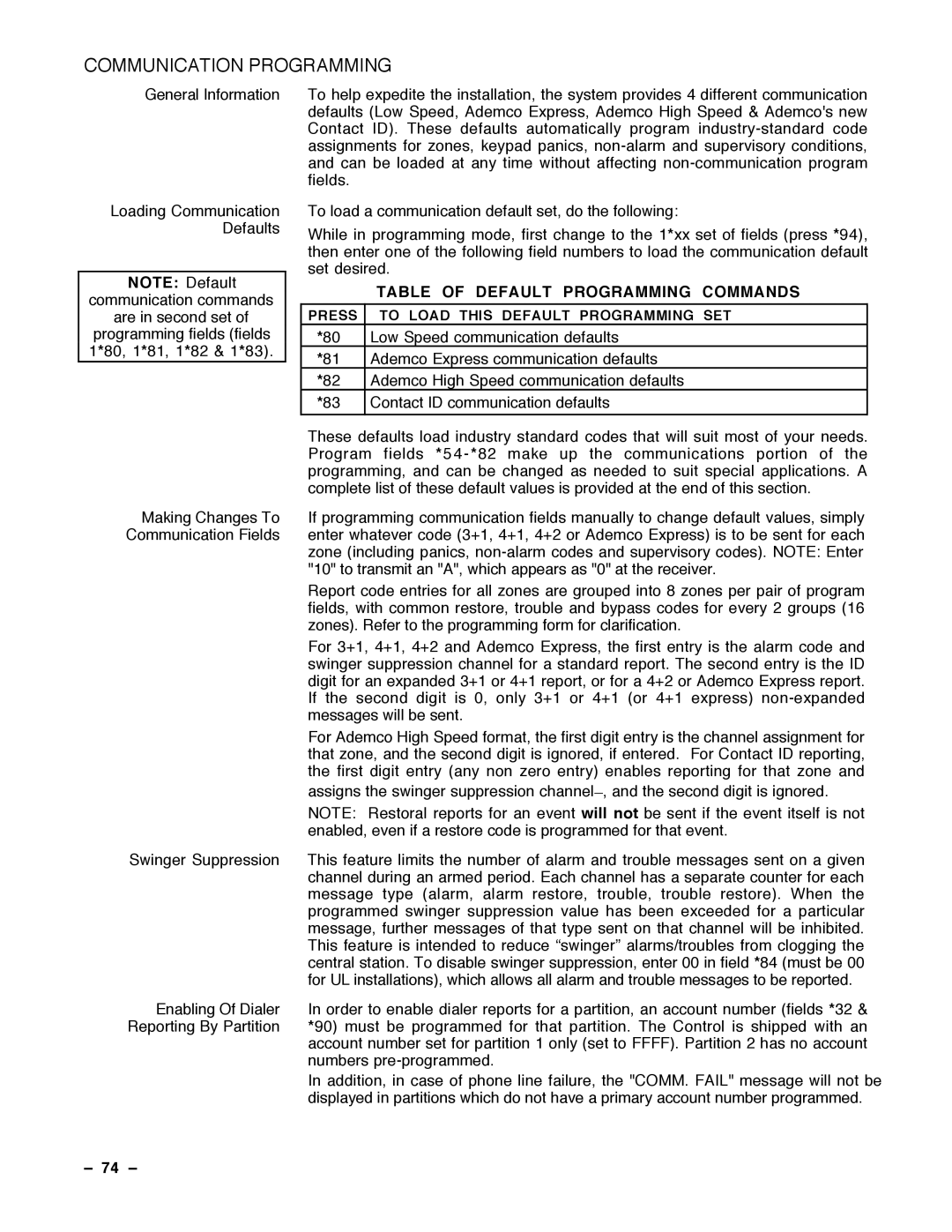
COMMUNICATION PROGRAMMING
General Information To help expedite the installation, the system provides 4 different communication defaults (Low Speed, Ademco Express, Ademco High Speed & Ademco's new Contact ID). These defaults automatically program
Loading Communication Defaults
NOTE: Default
communication commands
are in second set of programming fields (fields 1*80, 1*81, 1*82 & 1*83).
To load a communication default set, do the following:
While in programming mode, first change to the 1*xx set of fields (press *94), then enter one of the following field numbers to load the communication default set desired.
| TABLE OF DEFAULT PROGRAMMING COMMANDS |
PRESS | TO LOAD THIS DEFAULT PROGRAMMING SET |
*80 | Low Speed communication defaults |
*81 | Ademco Express communication defaults |
*82 | Ademco High Speed communication defaults |
*83 | Contact ID communication defaults |
|
|
| These defaults load industry standard codes that will suit most of your needs. |
| Program fields |
| programming, and can be changed as needed to suit special applications. A |
| complete list of these default values is provided at the end of this section. |
Making Changes To | If programming communication fields manually to change default values, simply |
Communication Fields | enter whatever code (3+1, 4+1, 4+2 or Ademco Express) is to be sent for each |
| zone (including panics, |
| "10" to transmit an "A", which appears as "0" at the receiver. |
| Report code entries for all zones are grouped into 8 zones per pair of program |
| fields, with common restore, trouble and bypass codes for every 2 groups (16 |
| zones). Refer to the programming form for clarification. |
| For 3+1, 4+1, 4+2 and Ademco Express, the first entry is the alarm code and |
| swinger suppression channel for a standard report. The second entry is the ID |
| digit for an expanded 3+1 or 4+1 report, or for a 4+2 or Ademco Express report. |
| If the second digit is 0, only 3+1 or 4+1 (or 4+1 express) |
| messages will be sent. |
| For Ademco High Speed format, the first digit entry is the channel assignment for |
| that zone, and the second digit is ignored, if entered. For Contact ID reporting, |
| the first digit entry (any non zero entry) enables reporting for that zone and |
| assigns the swinger suppression channel_, and the second digit is ignored. |
| NOTE: Restoral reports for an event will not be sent if the event itself is not |
| enabled, even if a restore code is programmed for that event. |
Swinger Suppression | This feature limits the number of alarm and trouble messages sent on a given |
| channel during an armed period. Each channel has a separate counter for each |
| message type (alarm, alarm restore, trouble, trouble restore). When the |
| programmed swinger suppression value has been exceeded for a particular |
| message, further messages of that type sent on that channel will be inhibited. |
| This feature is intended to reduce ÒswingerÓ alarms/troubles from clogging the |
| central station. To disable swinger suppression, enter 00 in field *84 (must be 00 |
| for UL installations), which allows all alarm and trouble messages to be reported. |
Enabling Of Dialer | In order to enable dialer reports for a partition, an account number (fields *32 & |
Reporting By Partition | *90) must be programmed for that partition. The Control is shipped with an |
| account number set for partition 1 only (set to FFFF). Partition 2 has no account |
| numbers |
| In addition, in case of phone line failure, the "COMM. FAIL" message will not be |
| displayed in partitions which do not have a primary account number programmed. |
